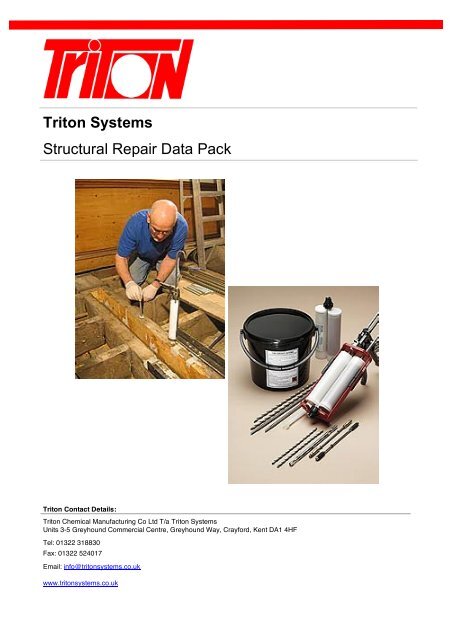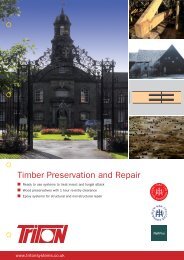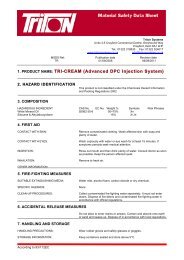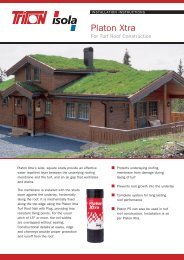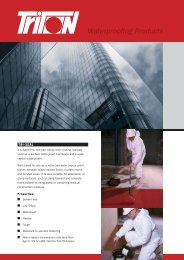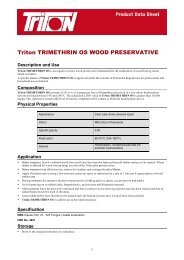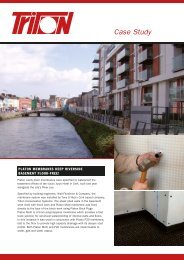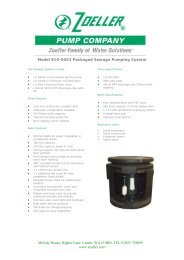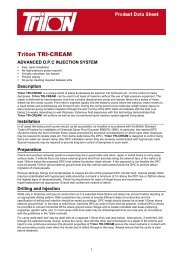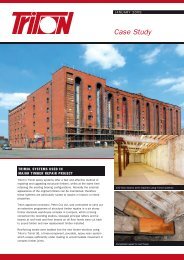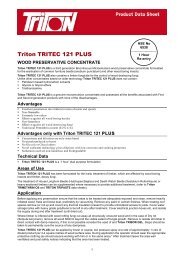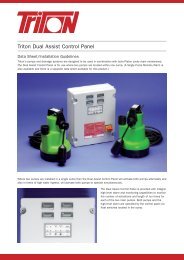Structural Repair Data Pack Download - Triton Chemicals
Structural Repair Data Pack Download - Triton Chemicals
Structural Repair Data Pack Download - Triton Chemicals
Create successful ePaper yourself
Turn your PDF publications into a flip-book with our unique Google optimized e-Paper software.
<strong>Triton</strong> TRIMOL 15 LIGHTWEIGHT MORTARDescription<strong>Triton</strong> TRIMOL 15 is a three component system comprising of a low viscosity epoxy resin, an almost colourless lowviscosity hardener and a khaki – grey low density filler, which provides a cold or warm setting, lightweight, low slump fillerfor use in non-structural applications.CharacteristicsThe mixture will remain in place on vertical and inverted surfaces and although it will form a strong bond to structuralmaterials it is best employed in conjunction with <strong>Triton</strong> TRIMOL 23, a Thixotropic adhesive, used as a primer.Uses<strong>Triton</strong> TRIMOL 15 is particularly suited to the fast, effective repair of concrete in vertical and overhead work and willrapidly attain mechanical strength sufficient to exceed that of good quality concrete.Trimol SystemProduct Appearance Density at 25°CTRIMOL 15 RESIN Pale golden liquid 1.14Instructions for usePRETREATMENT OF SURFACESTRIMOL 15 HARDENER Almost colourless liquid 1.02TRIMOL 15 FILLER Khaki – grey powder 0.35All surfaces must be free of contamination by dust, grease laitance and corrosion products. Concrete and mortars shouldbe shot –blasted or mechanically abraded or scabbled but need not necessarily be completely dry as both primer andlightweight mortar will bond to damp – but not wet substances.PrimingIt is strongly recommended that surfaces be primed with <strong>Triton</strong> TRIMOL 23 prior to application of lightweight mortar due tothe ʻdrynessʼ of the product. <strong>Triton</strong> TRIMOL 23 should be well brushed or knifed into the prepared areas and <strong>Triton</strong>TRIMOL 23 applied whilst the primer is still wet.MixingMix all resin and hardener thoroughly followed by addition of the filler, blending should continue until a homogenousmixture is achieved.Usable life 45 Mins at 20°C 1½ hours at 10°C 3 hours at 5°C
ApplicationThis may be by wooden or steel float or by gloved hand.Work or push the material into the primed surface and compact well, smooth off with a clean steel trowel or float.Curing<strong>Triton</strong> TRIMOL 15 will set within 6 hours at 20°C and will have achieved 90% of its ultimate mechanical and chemicalresistant qualities by 36 hours at 20°C.StorageThe separate components stored unopened at 5°C - 25°C in dry conditions have a shelf life of 2 years.Cleansing EquipmentClean before the mixture has hardened with <strong>Triton</strong> RESIN CLEANERCured Trimol 15Property Unit ValueSpecific Gravity MPa 0.70Flexural Strength MPa 18Compressive Strength MPa 35Linear shrinkage during cure at 20°Cfor 7 days% 0.03-0.05Caution<strong>Triton</strong> TRIMOL 15 Resin and hardener are generally harmless providing that the normal common-sense precautionstaken when handling chemicals are observed. For instance neither the separate components nor the uncured mixtureshould be allowed to come in contact with foodstuffs or utensils. Measures should also be taken to prevent contact withthe skin: wearing rubber or plastic gloves will normally suffice along with eye protection. Thoroughly cleanse the skin atthe end of each working period by washing with soap and warm water. Disposable paper towels are recommended todry the skin. Precautions are fully discussed in the <strong>Triton</strong> TRIMOL Handling Precautions sheet and also <strong>Triton</strong> TRIMOLProduct Safety Information for <strong>Triton</strong> TRIMOL 15 Resin and Hardener which are available upon request.Health & Safety For full information consult the relevant Material Safety <strong>Data</strong> Sheet..For further information please contact:<strong>Triton</strong> Chemical Manufacturing Co Ltd T/a <strong>Triton</strong> SystemsUnits 3 – 5 Crayford Commercial Centre, Greyhound Way, Crayford, Kent DA1 4HFTel: 01322 318830 Fax: 01322 524017 Email: info@tritonsystems.co.ukwww.tritonsystems.co.ukRef: <strong>Triton</strong> TRIMOL 15 07/11
<strong>Triton</strong> TRIMOL 23THIXOTROPIC EPOXY ADHESIVEDescription<strong>Triton</strong> TRIMOL 23 is two component solvent-free system, both components are Thixotropic. The resin component isblack and the hardener component is white thus a dark uniform grey is produced upon thorough mixing. <strong>Triton</strong> TRIMOL23 is formulated to provide an adhesive, which may be applied in cold, damp or dry conditions.CharacteristicsThe mixed adhesive remains in place on vertical or inverted surfaces and, when cured, forms strong bonds to moststructural materials, e.g., wood, metals, glass, reinforced plastics and laminates. <strong>Triton</strong> TRIMOL 23 is resistant to mostcommon chemicals – in case of doubt a telephone call to our Technical Department will result in an opinion regarding lifeexpectancy.Uses<strong>Triton</strong> TRIMOL 23 is well suited to applications in the building and civil engineering industries where a Thixotropic(negligible slump) adhesive or primer is required. Its ability to cure in damp, cold conditions is further enhanced as theadhesive will cure under water after placing.Trimol SystemProduct Appearance Density at 25°CTRIMOL 23 RESIN Black, Thixotropic paste 1.6Instructions for useSURFACE PRETREATMENTTRIMOL 23 HARDENER White, Thixotropic paste 1.4Contaminated surfaces can inhibit adhesion. Remove any surface deposits e.g., grease, dust or corrosion products. Foroptimum bond strength cementitious materials should be abraded by sand-blasting, needle-gunning, wire brushing, etc.any laitance on concrete should be 28 days old before using <strong>Triton</strong> TRIMOL 23. Metals should ideally be cleaned bysand or grit blasting. Thermoset plastics should be abraded and solvent washed.MixingThe entire contents of the hardener container should be mixed with the entire contents of the resin container and mixing witha spatula should be continued until an even grey colour is achieved.Usable lifeThe mixture has a usable life (pot-life) of:40 mins at 20° C 90 mins at 10°C 180 mins at 5°CApplication<strong>Triton</strong> TRIMOL 23 may be applied by trowel, very stiff brush, serrated spreader or spatula and worked in well. Recommended glue-line thickness: 1-30mm Joints must be closed whilst the adhesive is still tacky.
CuringUltimate bond strengths are achieved after 4-5 days at 20°C, however, the material will have gelled within 16-18 hours at20°C.CleaningAll tools and surfaces should be cleaned with <strong>Triton</strong> RESIN CLEANER before the mixture has hardened.StorageThe separate components stored in dry conditions at 5°C - 25°C have a shelf life of 18 months.Mechanical PropertiesThixotropic AdhesiveMechanical Properties after curing 21 days at 20°CTest temperature 20°CTensile strengthISO/R527Tensile modulus (E)ISO/R527Elongation breakISO 178Flexural strength*ISO 178Compressive strength*ISO 604MPa 14.8GPa 7.3% 1Mpa 37Mpa 8033Caution<strong>Triton</strong> TRIMOL 23 Resin and hardener are generally harmless providing that the normal common-sense precautionstaken when handling chemicals are observed. For instance neither the separate components nor the uncured mixtureshould be allowed to come in contact with foodstuffs or utensils. Measures should also be taken to prevent contact withthe skin: wearing rubber or plastic gloves will normally suffice along with eye protection. Thoroughly cleanse the skin atthe end of each working period by washing with soap and warm water. Disposable paper towels are recommended to drythe skin. Precautions are fully discussed in product safety information for <strong>Triton</strong> TRIMOL 23 resin and hardener, whichis available on request.RemovedIt is advised that cementitious finishes should be 28 days old.Health & SafetyFor full information consult the relevant Material Safety <strong>Data</strong> Sheet..For further information please contact:<strong>Triton</strong> Chemical Manufacturing Co Ltd T/a <strong>Triton</strong> SystemsUnits 3 – 5 Crayford Commercial Centre, Greyhound Way, Crayford, Kent DA1 4HFTel: 01322 318830 Fax: 01322 524017 Email: info@tritonsystems.co.ukwww.tritonsystems.co.ukRef: <strong>Triton</strong> TRIMOL 23 07/11
<strong>Triton</strong> TRIGROUT EXTRAHIGH PERFORMANCE CEMENT BASED STRUCTURAL GROUT<strong>Triton</strong> TRIGROUT EXTRA has been designed as a structural grout for the bedding and bonding of stainless steelreinforcement bar and wall ties. <strong>Triton</strong> TRIGROUT EXTRA is shrinkage compensated, non-gassing and thixotropic; it issuitable for application with hand or powered applicators.Key BenefitPre-<strong>Pack</strong>ed Powder and LiquidSimple MixingLong Pot-LifeExcellent Application PropertiesDescription and Use<strong>Triton</strong> TRIGROUT EXTRA is composed of Portland cement, quartz aggregates and water retention additives and ismixed with a pre-prepared SBR latex liquid before use. The thixotropic grout produced is placed in slots or holes inmasonry walls to bond spiral or helical stainless steel reinforcement bar or wall ties when carrying out crack stitching ormasonry reinforcement repairs.PreparationCut the slot or hole to the required size; in general there should be a minimum clearance of 2mm all round thecomponent being installed, e.g., for a 6mm bar or tie, a 10mm slot or hole should be cut. Very absorbent substrates mayrequire a larger clearance to be made. The depth cut for a slot will vary with the type of wall, for single skin or cavityconstruction a depth of 25-35mm is required, for solid walls a depth of 35-45mm should be cut. After slot cutting ordrilling, the hole should be flushed clean with water to allow for maximum bond strength to be obtained. Highly absorbentmaterials may need to be primed to reduce suction.Mixing<strong>Triton</strong> TRIGROUT EXTRA is supplied in plastic buckets containing all the powder and liquid needed to make up theproduct. No extra water is needed or added. Add the powder to the liquid in the supplied bucket. Mix thoroughly using apowered paddle for at least 2 minutes until a creamy lump free consistency is obtained. MIX ONLY WHOLE PACKS.Transfer the mixture into the grout injection gun and inject into the slot or hole in one, smooth, continuous operation,immediately apply the reinforcement bar or tie and apply further grout over the top as necessary. Aim to use up eachcartridge load within 5 minutes. The pot life of the mix is typically 45 minutes with re-stirring before loading the injectiongun.CuringExposed areas of grout should be protected from the wind and sun to maintain damp conditions for at least 3 days tomaximise strength development and shrinkage compensation. A primer may be needed on highly absorbent surfaces.DO NOT USE at ambient temperatures above 25°C or at 5°C or below (or if danger of frost).Clean UpClean out injection guns and tools with clean water immediately after use before the grout sets.
Health and Safety<strong>Triton</strong> TRIGROUT EXTRA contains Portland cement, which becomes alkaline when wet. Avoid contact with groutpowder and the mixed product.Refer to the product label and the Safety <strong>Data</strong> Sheet for more detailed information.<strong>Pack</strong>agingTwo pack sizes are available, producing 3 litres and 6 litres3 litres: 1 x 5kg <strong>Triton</strong> TRIGROUT EXTRA powder, 1 x 1tr Polymer gauging liquid6 litres: 2 x 5kg <strong>Triton</strong> TRIGROUT EXTRA powder, 1 x 1ltr Polymer gauging liquid.For further information please contact:<strong>Triton</strong> Chemical Manufacturing Co Ltd T/a <strong>Triton</strong> SystemsUnits 3 – 5 Crayford Commercial Centre, Greyhound Way, Crayford, Kent DA1 4HFTel: 01322 318830 Fax: 01322 524017 Email: info@tritonsystems.co.ukwww.tritonsystems.co.ukRef: <strong>Triton</strong> Trigrout Extra 07/11
<strong>Triton</strong> TRIFIX ADHESIVEDescription<strong>Triton</strong> TRIFIX is a two component epoxy resin system formulated for use with twin component side by side cartridgesusing either hand operated or, more normally, air operated guns, using “at the nozzle” static spiral mixer or pot mix forlarger applications.Characteristics<strong>Triton</strong> TRIFIX is colour coded for visual assurance that the two components are fully mixed. The product issolvent free, thixotropic i.e., will not readily slump, and cures in cold, damp conditions.Uses<strong>Triton</strong> TRIFIX is formulated as an adhesive for bonding and anchoring most building materials e.g. brick, stone, steel,mortar and timber. Once cured <strong>Triton</strong> TRIFIX creates a strong stress free joint regardless of the surroundingenvironment.*The colour, but no other ingredient, may be changed at the manufacturers discretion. The change will not affect thecured product in any way.Trimol SystemInstructions for useProduct Appearance Density at 25°CTRIFIX RESIN *Orange 1.7TRIFIX HARDENER *Red 1.2PRETREATMENTPrior to the application of <strong>Triton</strong> TRIFIX all surfaces must be free from dust, oil, rust and grease. Any loose materialsmust be removed back to a sound surface.MIXINGWhen supplied in cartridge form the mixing takes place in a static spiral mixer, which delivers the mixed product to therequired surface. When supplied in pots, all of the resin must be mixed with all of the hardener. Under no circumstancesshould part mixes be used. Mix the two components thoroughly until a consistent, no streaky colour is achieved. Whenusing cartridges, extrude <strong>Triton</strong> TRIFIX onto a surface until a consistent non-streaky colour is achieved.Usable lifeIn cartridges <strong>Triton</strong> TRIFIX has no waste apart from the mixed product in the nozzle, which will stay workable for aminimum of 15 mins. In pot form the mixed product will remain workable for approximately 15 mins. This time can varydepending upon the working temperature.CuringComplete Cure: 7 daysTestingNot less than 24 hours after application, the temperature to be 12°C or above.
Working temperatureThe material is formulated for use at 5°C to 25°C; it is seasonably adjusted during manufacture to ensure the flowcharacteristics of the mixed product are constant.Trifix AdhesiveMechanical properties after curing 21 days at 20°C.Test temperature: 20°C.Tensile strength 35 MPaISO/R 527Flexural strength 30 MPaISO 178Compressive strength 60 MPaStorageThe separate components, stored at 5°C to 20°C in dry conditions, have a shelf life of at lease 9 months.<strong>Pack</strong>aging400ml side-by-side cartridgeCleaningThe method of application cuts cleaning to a minimum but should it be necessary to clean then <strong>Triton</strong> RESIN CLEANERshould be employed: cured <strong>Triton</strong> TRIFIX ADHESIVE will require removal by chipping or other mechanical means.Caution<strong>Triton</strong> TRIFIX ADHESIVE is generally harmless providing that the normal common-sense precautions are taken whenhandling chemicals are observed. For instance neither the separate components nor the uncured mixture should beallowed to come into contact with foodstuffs or utensils. Measures should also be taken to prevent contact with the skin:wearing rubber or plastic gloves will normally suffice along with eye protection. Thoroughly cleanse the skin at the end ofeach working period by washing with soap and water. Disposable paper towels are recommended to dry the skin.Precautions are fully discussed in Product Safety Information sheet for <strong>Triton</strong> TRIFIX ADHESIVE, which is available onrequest.Health & SafetyFor full information consult the relevant Material Safety <strong>Data</strong> Sheet.For further information please contact:<strong>Triton</strong> Chemical Manufacturing Co Ltd T/a <strong>Triton</strong> SystemsUnits 3 – 5 Crayford Commercial Centre, Greyhound Way, Crayford, Kent DA1 4HFTel: 01322 318830 Fax: 01322 524017 Email: info@tritonsystems.co.ukwww.tritonsystems.co.ukRef: <strong>Triton</strong> TRIFIX ADHESIVE 07/11
<strong>Triton</strong> DOUBLE ADHESIVE TIE – AA10Description and UseThe <strong>Triton</strong> AA10 is a 10mm diameter stainless steel replacement wall tie, which can be used in situations that requireboth the inner and outer wall to be anchored with resin. It has the added advantage of being virtually self-centering. The“<strong>Triton</strong> AA10” tie has “waisted” ends which give the tie both a mechanical and an adhesive fixing, once the resin isapplied.<strong>Triton</strong> AA10 tie can be used in most building materials i.e. brick, lightweight block, timber and mortar.<strong>Triton</strong> AA10 tie is manufactured from austenitic stainless steel, of which grade 316 is used.<strong>Triton</strong> AA10 ties are available in various lengths to deal with varying cavity widths and construction types.ApplicationAn 11mm diameter hole is drilled through the outer wall and into the inner wall at a slightly inclined angle (asrecommended in BRE Digest 329) to a minimum depth of 56mm. The hole must then be blown out to remove dust etc.,prior to the installation of the resin.The resin is then applied to the inner wall, ensuring the hole is filled. The correct length tie should then be inserted andpushed manually to the back of the hole. Resin is then applied to the outer hole encasing the tie end. The hole shouldthen be capped off with mortar or mastic.Load TestingThe <strong>Triton</strong> AA10 tie has an inbuilt feature that enables load tests to be carried out on site on the inner leaf if necessary.Two projections are formed extending inwardly into the bore of the tubular body on the outer end of the tie.A load test adaptor is supplied which has a 6mm thread on the outer end for connecting to the load test equipment andtwo slots for passing over the projections in the wall tie at the opposite end. With the two flats on the major diameter ofthe adaptor in the vertical position, fit the slotted end into the bore of the wall tie. Turn adaptor through 90 degrees andin this position the head is engaged behind the projections and the load can be applied.Typical loads achieved are in excess of 2.5 kn.<strong>Pack</strong>aging<strong>Triton</strong> AA10 ties are packed in boxes of 100.For further information please contact:<strong>Triton</strong> Chemical Manufacturing Co Ltd T/a <strong>Triton</strong> SystemsUnits 3 – 5 Crayford Commercial Centre, Greyhound Way, Crayford, Kent DA1 4HFTel: 01322 318830 Fax: 01322 524017 Email: info@tritonsystems.co.ukwww.tritonsystems.co.ukRef: <strong>Triton</strong> AA10 07/11
<strong>Triton</strong> DOUBLE ADHESIVE TIE RR10Description and UseThe <strong>Triton</strong> RR10 is a 5mm diameter stainless steel replacement wall tie which can be used in situations that require boththe inner and outer wall to be anchored with resin.The RR10Consists of a 5mm stainless steel bar with two 10mm nuts on each end of the tie with a centre drip.The <strong>Triton</strong> RR10 tie is manufactured from 304 grade austenitic stainless steel.ApplicationA 10mm diameter hole is drilled through the outer leaf brick and into the inner leaf to a minimum depth of 55mm. Thehole should be drilled at a slightly inclined angle to avoid ingress of dampness (as recommended in Bre Digest 329) andblown out to remove any loose dust and drillings. Care must be taken in selecting the correct length wall tie for theappropriate cavity width. <strong>Triton</strong> TRIFIX RESIN must then be injected into the inner leaf hole and the <strong>Triton</strong> RR10pushed across the cavity and firmly into the resin filled hole. Resin is then applied to the outer hole encasing the tie end.The hole should then be capped off with mortar or mastic.Load TestingsOnce the resin has cured a pull test on the inner leaf can be performed using the appropriate adaptor and testingmachine.Typical loads achieved are in excess of 2.5kn..For further information please contact:<strong>Triton</strong> Chemical Manufacturing Co Ltd T/a <strong>Triton</strong> SystemsUnits 3 – 5 Crayford Commercial Centre, Greyhound Way, Crayford, Kent DA1 4HFTel: 01322 318830 Fax: 01322 524017 Email: info@tritonsystems.co.ukwww.tritonsystems.co.ukRef: <strong>Triton</strong> RR10 07/11
<strong>Triton</strong> EXPANDING RESIN TIE – ER10Description and UseThe <strong>Triton</strong> ER10 is a 10mm diameter replacement cavity wall tie, that combines 304 grade austenitic stainless steel andNeoprene.The <strong>Triton</strong> ER10 is most suited to situations where the outer leaf is of a solid construction and the inner leaf is of aweaker material (blockwork) as one end of the tie is resin bonded into the structure, and the other end is expanded toform a fix.ApplicationA 11mm diameter hole is drilled through the outer leaf brick and into the inner leaf to a minimum depth of 55mm. Thehole should be drilled at a slightly inclined angle to avoid ingress of dampness, (as recommended in BRE Digest 329)and blown out to remove any loose dust and drillings. Care must be taken in selecting the correct length wall tie for theappropriate cavity width. Suitable resin must then be injected into the inner leaf hole and then the ER10 pushed acrossthe cavity and firmly into the resin filled hole. The resin must then be given appropriate time to cure. (See manufacturersinstruction). Once the resin has cured a pull test on the inner leaf can be performed if required, using the appropriateadaptor and testing machine.The outer leaf is loaded by fitting the fixing tool on to the inner nut and turning clockwise until hand tight. If testing isrequired on the completed installation it is performed as described previously.Typical loads achieved are in excess of 2.5kn.If further information or a site demonstration is required contact our technical department.<strong>Pack</strong>agingThe <strong>Triton</strong> ER10 is packed in boxes of 200..For further information please contact:<strong>Triton</strong> Chemical Manufacturing Co Ltd T/a <strong>Triton</strong> SystemsUnits 3 – 5 Crayford Commercial Centre, Greyhound Way, Crayford, Kent DA1 4HFTel: 01322 318830 Fax: 01322 524017 Email: info@tritonsystems.co.ukwww.tritonsystems.co.ukRef: <strong>Triton</strong> ER10 07/11
<strong>Triton</strong> RESIN / MECHANICAL TIE RS10Description and UseThese ties are used in situations where the inner leaf construction is of low compressive strength i.e., normally below7n/mm².The inner “wavy tail” end has been in use for over 20 years and is acknowledged as being the best possible resin anchordesign.<strong>Triton</strong> RS10The <strong>Triton</strong> stainless steel expander is designed to provide a wide range of fixings into soft and hard materials alikewithout undue relaxation or creep under continuous tensile and compressive loading or cyclical vibration by using strip ofa precise thickness, high localized compressive point loads that are normally associated with conventional expanders arereduced; thereby reducing the possibility of cracking the masonry.Installation Procedure1. Drill a 23mm diameter hole through the masonry to a depth of 55mm in the inner leaf. Remove all dust and debrisfrom the hole.2. Inject a quantity of <strong>Triton</strong> TRIFIX RESIN into the inner leaf hole, via a resin extension tube. Insert the wavy end ofthe remedial tie into the resin and push firmly home.3. When the resin has set, undertake a pull test, if required.4. Tighten the outer expander to the specified torque setting.5. make good the hole with matching mortar.The metallic components of these ties are manufactured from 304 grade austenitic stainless steel..For further information please contact:<strong>Triton</strong> Chemical Manufacturing Co Ltd T/a <strong>Triton</strong> SystemsUnits 3 – 5 Crayford Commercial Centre, Greyhound Way, Crayford, Kent DA1 4HFTel: 01322 318830 Fax: 01322 524017 Email: info@tritonsystems.co.ukwww.tritonsystems.co.ukRef: <strong>Triton</strong> RS10 07/11
<strong>Triton</strong> EE10 SINGLE FIX WALL TIEDescription and UseThe stainless steel double expansion remedial wall ties are manufactured from Neoprene and Austenetic 304 GradeStainless Steel. The tie has been designed with neoprene expanders being more sympathetic to the material we arefixing to. It uses a newly designed torque nut to set both the inner and outer expanders independently. The inner fix isaffected by a ribbed neoprene, which gives the best possible grip on the inner leaf. This design is an improvement overother ties where the expanders have to be continually taken out, pre-expanded and re-inserted to effect a fix.ApplicationAn 11mm diameter hole is drilled through the outer leaf brick and into the inner leaf brick to a minimum, depth of 55mm.The hole should be drilled at a slightly inclined angle to avoid ingress of dampness (as recommended in BRE Digest 329)and if necessary, blow out to remove any loose dust and drillings. Care must be taken in selecting the correct length walltie for the appropriate cavity width.The <strong>Triton</strong> EE10 is then inserted into the hole and located into the hole in the inner leaf. The <strong>Triton</strong> EE10 should be leftapproximately 10mm inside the face of the outer brickwork. Once in place the setting tool, held in a suitable cordlessdrill, should be applied to the torque nut to expand the inner body. At a pre-set strength the torque nut will then rundown the thread. If a pull test is required for the inner leaf only, it should now be carried out using the appropriateadapter and testing machine.The outer leaf is loaded by continuing to set the nut with the drill and tool. If testing is required on the completedinstallation it is performed as described previously.Typical loads achieved are in excess of 2.3kn.Below are listed typical tensile failure loads under testing in accordance with BSI DD140 Part 1 and provide indicativevalues of the tie performance in various base materials. The couplet test produces results of a conservative naturecompared to actual wall tests.Base MaterialCompressive Strength(N/mm²)Tie Anchorage(Kn)Common facing brick 19-25.5 7.01Deep frogged brick 18-25.0 6.52Dense concrete block 7-19.3 3.12Lightweight concrete block 2.3-3.2 1.78NOTE: The above results are mean failure loads and are either the ultimate pull out load or the load at a deformation of 5mm,whichever occurred first.For further information please contact:<strong>Triton</strong> Chemical Manufacturing Co Ltd T/a <strong>Triton</strong> SystemsUnits 3 – 5 Crayford Commercial Centre, Greyhound Way, Crayford, Kent DA1 4HFTel: 01322 318830 Fax: 01322 524017 Email: info@tritonsystems.co.ukwww.tritonsystems.co.ukRef: <strong>Triton</strong> EE10 07/11
<strong>Triton</strong> PB10 DOUBLE EXPANDING TORQUE NUTWALL TIEDescription and UseThe stainless steel double expansion remedial wall ties are manufactured from Brass and Austenetic 304 GradeStainless Steel. The tie has been designed with brass expanders being more sympathetic to the material we are fixingto. It uses a newly designed torque nut to set both the inner and outer expanders independently. The inner fix isaffected by a crimped nut which gives the best possible grip on the inner leaf and forces a free moving cone into theexpander. This design is an improvement over other ties where the expanders have to be continually taken out, preexpandedand re-inserted to effect a fix.ApplicationA 10mm diameter hole is drilled through the outer leaf brick and into the inner leaf brick to a minimum, depth of 55mm.The hole should be drilled at a slightly inclined angle to avoid ingress of dampness (as recommended in BRE Digest 329)and if necessary, blow out to remove any loose dust and drillings. Care must be taken in selecting the correct length walltie for the appropriate cavity width.The <strong>Triton</strong> PB10 is then inserted into the hole and located into the hole in the inner leaf. The <strong>Triton</strong> PB10 should be leftapproximately 10mm inside the face of the outer brickwork. Once in place the setting tool, held in a suitable cordlessdrill, should b applied to the torque nut to expand the inner body. At a pre-set strength the torque nut will then run downthe thread. If a pull test is required for the inner leaf only, it should now be carried out using the appropriate adapter andtesting machine.The outer leaf is loaded by continuing to set the nut with the drill and tool. If testing is required on the completedinstallation it is performed as described previously.Typical loads achieved are in excess of 2.5kn.Below are listed typical tensile failure loads under testing in accordance with BSI DD140 Part 1 and provide indicativevalues of the tie performance in various base materials. The couplet test produces results of a conservative naturecompared to actual wall tests.Base MaterialCompressive Strength(N/mm²)Tie Anchorage(Kn)Common facing brick 19-25.5 7.01Deep frogged brick 18-25.0 6.52Dense concrete block 7-19.3 3.12Lightweight concrete block 2.3-3.2 1.78NOTE: The above results are mean failure loads and are either the ultimate pull out load or the load at a deformation of 5mm,whichever occurred first.SpecificationCertification of conformity. All brass is manufactured from CZ121 1986 and conforms with BS-EN12164/BS2874.For further information please contact:<strong>Triton</strong> Chemical Manufacturing Co Ltd T/a <strong>Triton</strong> SystemsUnits 3 – 5 Crayford Commercial Centre, Greyhound Way, Crayford, Kent DA1 4HFTel: 01322 318830.Fax: 01322 524017 Email: info@tritonsystems.co.ukwww.tritonsystems.co.ukRef: <strong>Triton</strong> PB10 07/11
<strong>Triton</strong> LATERAL RESTRAINTDescription and Use<strong>Triton</strong> LATERAL RESTRAINTS are manufactured from 304 austenitic Stainless Steel rods 8mm in diameter. These aresupplied in standard lengths of 1 metre but are available in any length by prior arrangement.<strong>Triton</strong> LATERAL RESTRAINTS are designed to restrain the whole of the brick outer structure to the floor joists.The process would normally be done by using angle straps screwed onto the joists. This has several drawbacks:The disturbance caused to the householder is quite considerable.The fixing to the joist is only as strong as the shear strength of the screw heads.If there is fitted furniture or bathroom suites these have to be removed which would involve using specialist tradessuch as joiners and plumbers.The <strong>Triton</strong> LATERAL RESTRAINTS can be fitted from outside the property with a minimum of disturbance - in mostcases just a lifting of the floorboards to determine the position of the joists.The same restraint is used to suit different situations i.e. joists bearing into the wall and joists parallel to the wall.Installation Procedure1. Drill a 14mm hole through both brick outer and inner leaf.2. Push the long restraint into the pilot hole and attach the restraint fixing tool provided. The restraint is then slowlywound through the joists leaving the outer end recessed approximately 10-15mm. The outer end can then be testedfor the strength of fix. Typical test results range from 5kn-10kn. The outer end is then resin bonded into thebrickwork and finished off with either mortar or mastic.3. Tools required to fix <strong>Triton</strong> LATERAL RESTRAINTS:a. 14 x 460mm drill bitb. 1 Fixing Kitc. 1 Drilling Machined. 2 Spanners to suite. Trifix Resin.For further information please contact:<strong>Triton</strong> Chemical Manufacturing Co Ltd T/a <strong>Triton</strong> SystemsUnits 3 – 5 Crayford Commercial Centre, Greyhound Way, Crayford, Kent DA1 4HFTel: 01322 318830 Fax: 01322 524017 Email: info@tritonsystems.co.ukwww.tritonsystems.co.ukRef: <strong>Triton</strong> Lateral Restraint 07/11


